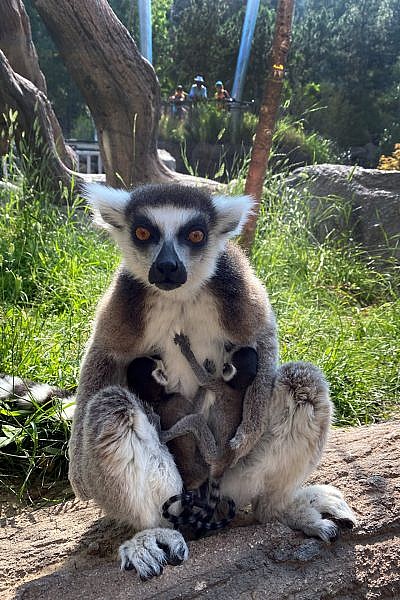RING-TAILED LEMUR MOM, ALLAGASH, WELCOMES TWINS TO WATER’S EDGE: AFRICA – Keepers at Water’s Edge: Africa were seeing double Sunday morning as they welcomed twins to the ring-tailed lemur family. Around 6 a.m. on Sunday, July 11, animal staff spotted first-time mom, 8-year-old Allagash (AL-uh-gash), holding an infant lemur and then confirmed a second stripy bundle of joy had arrived. The twins are the second and third ring-tailed lemurs born this year at Cheyenne Mountain Zoo. Allagash’s sister, Rogue, welcomed her first baby on April 26, 2021.

“Allagash is probably our feistiest lemur, so we’re excited to see how her bold personality translates to motherhood,” said Philip Waugh, lead keeper in Water’s Edge. “We’ve heard her cooing gently to her babies while they nurse, which is something we didn’t see with Rogue. She has her hands full with these twins, but she seems to be embracing her natural instincts to groom, feed, snuggle and protect them.”
The tiny newborns can be difficult to spot, since they’re typically cuddled up to mom’s chest for the first couple of weeks. Rogue’s baby has been curious about the new residents, leaping over to its aunt Allagash to get a quick look at the newborns before excitedly pouncing away. Six ring-tailed lemurs now share their waterfront home in the new exhibit, which opened in June 2020: Hercules, 4-year-old dad; Allagash, 8-year-old mom; Rogue, 8-year-old sister/aunt; Rogue’s 11-week-old baby and the newborn twins.
Staff have seen the babies nursing and consistently clinging to mom, which indicate the babies are healthy and bonding well with Allagash. The sexes of the twins have not been identified, but CMZoo will share updates on its social media channels as the team learns more about them. As long as all continues to go well for the lemurs, guests can see them right away.
“They’re so cute with their bandit-like eye markings and big fluffy ears,” said Waugh. “We have a trusting relationship with Allagash, so she’s been happy to let us get close enough to visually check on her and the little ones. She’s doing a great job. We’re going to follow Allagash’s lead as long as things are going well, and we’re here to support her if she needs us.”
CMZoo veterinary and animal staff are closely monitoring mom and her new babies, but won’t get the babies in hand unless they see it’s medically necessary.
According to the Lemur Conservation Foundation, lemurs are among the most threatened groups of mammals. The International Union for the Conservation of Nature (IUCN) estimates that over 95 percent of lemurs face extinction in the next 20 years. Ring-tailed lemurs are endangered, according to the IUCN. Hercules has breeding recommendations with Allagash and Rogue, as part of the ring-tailed lemur Species Survival Plan, managed cooperatively by members of Association of Zoos and Aquariums-accredited facilities, like CMZoo.
CMZoo was aware of Allagash’s pregnancy and had been monitoring her and the twins regularly. Lemur gestation periods last about 135 days. Breeding females typically have one baby per year, but twins can be common when food is abundant. Newborn lemurs cling closely to the mother’s abdomen for about two weeks, then will start to ride on her back. After about month, the young lemurs start exploring more independently until they’re fully weaned at about five or six months. More about ring-tailed lemurs at Cheyenne Mountain Zoo.
About Cheyenne Mountain Zoo
Cheyenne Mountain Zoological Society was founded in 1926. Today, Cheyenne Mountain Zoo, America’s mountain Zoo, offers comprehensive education programs, exciting conservation efforts and truly fantastic animal experiences. In 2021, Cheyenne Mountain Zoo was voted #4 Best Zoo in North America and CMZoo’s Rocky Mountain Wild was named #3 Best Zoo Exhibit in North America by USA TODAY 10Best Readers’ Choice Awards. It is Cheyenne Mountain Zoo’s goal to help guests fall in love with animals and nature, and take action to protect them. Of the 233 zoos and aquariums accredited by the Association of Zoos and Aquariums (AZA), Cheyenne Mountain Zoo is one of very few operating without tax support. Cheyenne Mountain Zoo depends on admissions, membership dues, special event attendance and donations for funding.

